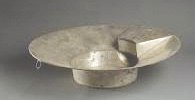In the Alexander King House Museum attic are two bathtubs from the 1800s. Early Americans did not bathe much. Most used a wash basin to clean face, hands and other parts, as needed. They weren’t like the Greeks and Romans who bathed regularly at home or socialized in public baths. Some colonists bathed, but infrequently, and probably not in the cold winter months. For those who did, when winter clothes were sloughed off in spring’s warmer weather, it was a good time to bathe – perhaps a sort of spring cleaning.
By the time colonists arrived in America, the Black Death had turned people away from bathing. Early Americans believed that soap stripped the body of natural protective oils and bathing spread disease. Outer clothing was not cleaned often but undergarments were laundered frequently and believed to block disease by absorbing the body’s impurities, dirt and sweat. White collars, particularly on vicars, were extensions of undergarments and symbolically demonstrated cleanliness, both physically and morally.
Lord Dunmore, a British governor of Virginia before the Revolutionary War, installed a bathhouse on his property, not for bathing but to have tubs of cool water poured over him during the hot summers. After using a newly built outside shower, Elizabeth Drinkwater, a colonial housewife from Pennsylvania, noted that she hadn’t washed her body in its entirety in 28 years.
George Washington was an advocate of bathing and frequently visited hot springs in eastern West Virginia. John Adams visited a natural spring in Stafford Springs. Suffield also had a mineral spring located on what is now known as Poole Road. Dr. Alexander King promoted drinking from it. In 1807, Ebenezer King III and his brother Fidelio, possibly related to Alexander, bought the property, and built a spa and hotel.
Benjamin Franklin air-bathed and water-bathed in the nude, sometimes embarrassing visitors. Thomas Jefferson believed that warm water produced boils and bathing was unhealthy. Alexander Hamilton meticulously washed daily. His clothing was washed after each wearing. In hot weather, he changed his clothes several times a day. Samuel Adams seldom bathed, was slovenly, smelly and wasn’t well-liked.
Early bathtubs were portable, of no standard shape, made from wood or metal. In many cases, they were the same tubs used for laundry. Water had to be carried in to fill the tub and heated. Afterwards, the tub had to be emptied. It was an arduous process. Some used the laundry’s waste water for bathing. The youngest often used the same water as the ones before.

Hat bathtub similar to the one exhibited at the King House Museum
The portable bathtubs in the King House Museum are probably from the mid-1800s. One is a hat bathtub which appeared in an early 1900 Sears and Roebuck catalog, although it was patented in the mid-1800s. The tub looks like an upside-down hat with a large brim. The bather sat or stood while water was poured over him. The other is a sitz bathtub, said to provide relief from childbirth, inflammation of the brain and organs of the chest and nervous fevers. The bather sat in the deep tub, resting against the inclined back, with feet dangling over the edge. A similar one was advertised in the 1902 Sears and Roebuck catalog.
Although Washington recommended that soldiers regularly bathe during the Revolutionary War, it was not until the Civil War that good hygiene and bathing became required sanitary measures. After that, soap for bathing was in demand. Ivory soap was introduced in 1879; Palmolive soap came out in 1898. And eventually, bathing evolved from a one-time spring-cleaning activity to an everyday affair.
If you want to see the antique bathtubs, The King House Museum is open May through September on Wednesdays and Saturdays, from 1 to 4 p.m.